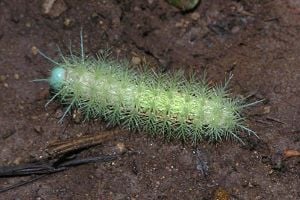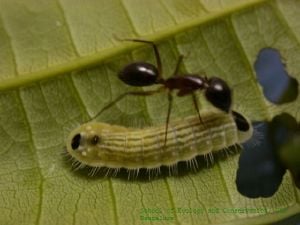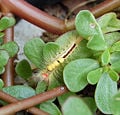Caterpillar
A caterpillar is the larval stage of a member of the order Lepidoptera (the insect order comprising butterflies and moths). They are essentially eating machines, mostly consuming leaves and other plant material (phytophagous), with some species eating other insects (entomophagous), spending most of their time in search of food.
Caterpillars grow through a series of molts and each intermediate stage is called an instar.Near the end of each instar, the larva undergoes a process called apolysis, in which the cuticle, the tough covering that is a mixture of chitin and specialized proteins, is released from the epidermis and the epidermis begins to form a new cuticle beneath. At the end of each instar, the larva molts the old cuticle, and the new cuticle rapidly hardens and pigments. Development of wing patterns begins by the last larval instar.
Being voracious feeders, many caterpillars are considered as pests in agriculture. Many moth species are better known in their caterpillar stages because of the damage they cause to fruits and other agricultural produce.
Morphology
1. Head 2. Thorax 3. Abdomen 4. Spiracle 5. Anal Prolegs 6. Abdominal Prolegs 7. Segment 8. Thoracic legs 9. Antenna
Most caterpillars have tubular, portioned bodies. They have three pairs of true legs on the three thoracic segments, up to four pairs of prolegs on the middle segments of the abdomen, and often a single pair of prolegs on the last abdominal segment. There are ten abdominal segments. The families of lepidoptera differ in the numbers and positioning of the prolegs. The geometrids, also known as inchworms or loopers, are so named because of the way they locomote, appearing to measure the earth (the word geometrid means earth-measurer in Greek); the primary reason for this unusual locomotion is the elimination of nearly all the prolegs except the clasper on the terminal segment. Caterpillars have soft bodies that can grow rapidly, like balloons, between moults. Only the head capsule is hardened. In caterpillars, the mandibles are tough and sharp for chewing leaves; in most adult Lepidoptera, the mandibles are highly reduced, or soft. Behind the mandibles of the caterpillar are the spinnerets, for manipulating silk.
Some larvae of the Hymenoptera (Ants, bees and wasps) order can appear like the caterpillars of the lepidoptera. These are mainly seen in the Sawfly family and while the larvae superficially resemble caterpillars, they can be distinguished by the presence of prolegs on every abdominal segment. Another difference is that lepidopteran caterpillars have crochets or hooks on the prolegs while these are absent on the sawfly larvae. Another difference in lepidopteran caterpillars is the upside down Y shaped suture on the front of the head.[1] The larvae of sawflies differ also in having prominent ocelli on the head capsule.
Like all insects, caterpillars breathe through a series of small openings along the sides of their thorax and abdomen called spiracles. These branch into the body cavity into a network of tracheae.
Caterpillars have 4,000 muscles (the human being has only 629!). They move through contraction of the muscles in the rear segments pushing the blood forward into the front segments elongating the torso. The average caterpillar has 248 muscles in the head segment alone.
Caterpillars do not have good vision. They have a series of six tiny eyelets or 'stemmata' on each side of the lower portion of their head. These can probably form well focused, but poorly resolved images.[1] They move their heads from side to side probably as a means of judging distance of objects, particularly plants. They rely on their short antennae to help them locate food.
Some caterpillars are able to detect vibrations, usually at a highly specific frequency. Caterpillars of the common hook-tip moth, Drepana arcuata (Drepanoidea) produce sounds to defend their silk nests from members of their own species,[2] by scraping against the leaf in a ritualized acoustic duel. They detect the vibrations conducted by the plant and not air-borne sounds. Similarly, cherry leaf rollers Caloptilia serotinella defend their rolls.[3] Tent caterpillars can also detect vibrations at the frequency of wing beats of one of their natural enemies. [4]
Defense
Many species of animals feed on caterpillars as they are protein rich, and caterpillars in turn have evolved various defenses. Some caterpillars have large false eyes towards the rear of their abdomen. This helps convince predators that their back is actually their front, giving them an opportunity to escape when attacked. Others have a body coloration that closely resembles their food plant, or common objects in the environment, such as bird droppings or twigs. Many feed in leaf mines, ties, rolls or silk galleries. Others will use startle or intimidation, with the sudden presentation of eyespots or snake mimicry. Some species use a silk line and drop off the branches when disturbed.
Some caterpillars will regurgitate acidic digestive juices at attacking enemies. Many papilionid larvae produce bad smells from extrudable glands called osmeteria.

More aggressive self-defense measures are taken by hairy caterpillars. These caterpillars have spiny bristles or long fine hair-like setae with detachable tips that will irritate by lodging in the skin or mucous membranes.[1] However, some birds, like cuckoos, will swallow even the hairiest of caterpillars. The most aggressive defenses are those of the many caterpillars that have bristles associated with venom glands, called urticating hairs, and one of these is among the most potent defensive chemicals in any animals is produced by the South American silk moth genus Lonomia. The defensive chemical is an anticoagulant of such potency that it can kill a human, causing them to hemorrhage to death (See Lonomiasis).[5] This chemical is being investigated for potential medical applications. Most urticating hairs however range in effect from mild irritation to dermatitis.
Some caterpillars eat the leaves of plants that are toxic to other animals. They are unaffected by the poison themselves, but it is sequestered in their body, making them highly toxic. These chemicals are also carried on into the adult stages. These toxic species, such as the Cinnabar moth (Tyria jacobaeae) caterpillars, are usually advertised with brightly striped or coloured in black, red and yellow—the danger colours (see aposematism). The aim of all these aggressive defense measures is to assure that any predator that eats (or tries to eat) one of them will learn and avoid future attempts.
Some caterpillars obtain protection by associating themselves with ants. The Lycaenid butterflies are particularly well known for this. They communicate with their ant protectors by means of vibrations as well as chemical means. [6]
Some caterpillars are gregarious and such aggregations are believed to help in reducing the levels of parasitization.[7]
Some caterpillars, when they are young, have white eyes. As they mature, their eyes grow darker.
Behavior
Caterpillars have rightly been called eating machines. They eat leaves voraciously, shed their skins generally four or five times, and eventually pupate into an adult form. Measured by weight increase, caterpillars have a very fast growth rate. For instance, a tobacco hornworm will increase its own weight ten thousand times in less than twenty days. One of their adaptations that enables them to eat this much is a mechanism in a specialized midgut which transports ions at a very high rate to the lumen (midgut cavity), to keep the potassium level higher in the midgut cavity than in the blood.[8]
Caterpillars are predominantly herbivores: 99% of species feed on plants. A few feed on detritus including the clothes moth. Of those that are predatory, most feed on eggs of other insects, aphids, scale insects, or ant larvae. Some are cannibals, and others prey on caterpillars of other species (e.g. Hawai'ian Eupithecia ). A few are parasitic on cicadas or leaf hoppers.[9]
Some Hawai'ian caterpillars (Hyposmocoma molluscivora) use silk traps to capture snails.[10]
Economic importance
Caterpillars are of immense economic importance. They can both cause damage and help in production. The silkworm is a caterpillar which has spawned an entire industry. Species like the Cotton bollworm are known to cause enormous losses to farmers. They have been the target of pest control through the use of pesticides, biological control and agronomic practices. Many species have become resistant to pesticides. Bacterial toxins such as those from Bacillus thuringiensis which are evolved to affect the gut of lepidoptera have been used in sprays of bacterial spores, toxin extracts and also by incorporating genes to produce them within the host plants. These approaches are defeated over time by the evolution of resistance mechanisms in the caterpillar targets.
Host plants themselves evolve mechanisms of resistance to herbivory by caterpillars and these include the evolution of chemical toxins and physical barriers such as hairs. Incorporating host plant resistance (HPR) through plant breeding is another approach used in reducing the impact of caterpillars on crop plants.
ReferencesISBN links support NWE through referral fees
- ↑ 1.0 1.1 1.2 Scoble, MJ. 1995. The Lepidoptera: Form, function and diversity. Oxford Univ. Press.
- ↑ Yack JE, Smith ML, and Weatherhead PJ. 2001. Caterpillar talk: Acoustically mediated territoriality in larval Lepidoptera. Proceedings of the National Academy of Sciences of the United States of America 98 (20): 11371–11375.
- ↑ Fletcher LE, Yack JE, Fitzgerald TD, Hoy RR . 2006. Vibrational communication in the cherry leaf roller caterpillar Caloptilia serotinella (Gracillarioidea : Gracillariidae). Journal of Insect Behavior 19 (1): 1–18.
- ↑ Fitgerald, TD. 1995. The tent caterpillars. Cornell Univ. Press.
- ↑ Malaque, Ceila M. S., Lúcia Andrade, Geraldine Madalosso, Sandra Tomy, Flávio L. Tavares, And Antonio C. Seguro. 2006. A case of hemolysis resulting from contact with a Lonomia caterpillar in southern Brazil. Am. J. Trop. Med. Hyg., 74(5): 807-809
- ↑ Travassos, MA, and NE Pierce. 2000. Acoustics, context and function of vibrational signalling in a lycaenid butterfly–ant mutualism. Animal Behaviour 60: 13-26
- ↑ Entry, Grant L. G., Lee A. Dyer. 2002 ON THE CONDITIONAL NATURE OF NEOTROPICAL CATERPILLAR DEFENSES AGAINST THEIR NATURAL ENEMIES. Ecology, 83(11):3108–3119
- ↑ Chamberlin, M.E. and M.E. King (1998). Changes in midgut active ion transport and metabolism during the fifth instar of the tobacco hornworm (Manduca sexta). J.Exp.Zool. 280:135-141.
- ↑ Pierce, N.E. 1995. Predatory and parasitic Lepidoptera: Carnivores living on plants. Journal of the Lepidopterist's Society 49 (4): 412-453
- ↑ Rubinoff, Daniel and William P. Haines. 2005. Web-Spinning Caterpillar Stalks Snails. Science 309(5734): 575. DOI: 10.1126/science.1110397
See also
- Caterpillar tracks
- Pests & Diseases of Roses
External links
- Larva Locomotion: A Closer Look — video clips showing how monarch larvae walk
- More video clips from nature
- 3D animation Papilio polyxenes larvae walking
Photo gallery
- Calliteara pudibunda 9117.jpg
Calliteara pudibunda (purple)
Credits
New World Encyclopedia writers and editors rewrote and completed the Wikipedia article in accordance with New World Encyclopedia standards. This article abides by terms of the Creative Commons CC-by-sa 3.0 License (CC-by-sa), which may be used and disseminated with proper attribution. Credit is due under the terms of this license that can reference both the New World Encyclopedia contributors and the selfless volunteer contributors of the Wikimedia Foundation. To cite this article click here for a list of acceptable citing formats.The history of earlier contributions by wikipedians is accessible to researchers here:
The history of this article since it was imported to New World Encyclopedia:
Note: Some restrictions may apply to use of individual images which are separately licensed.





















